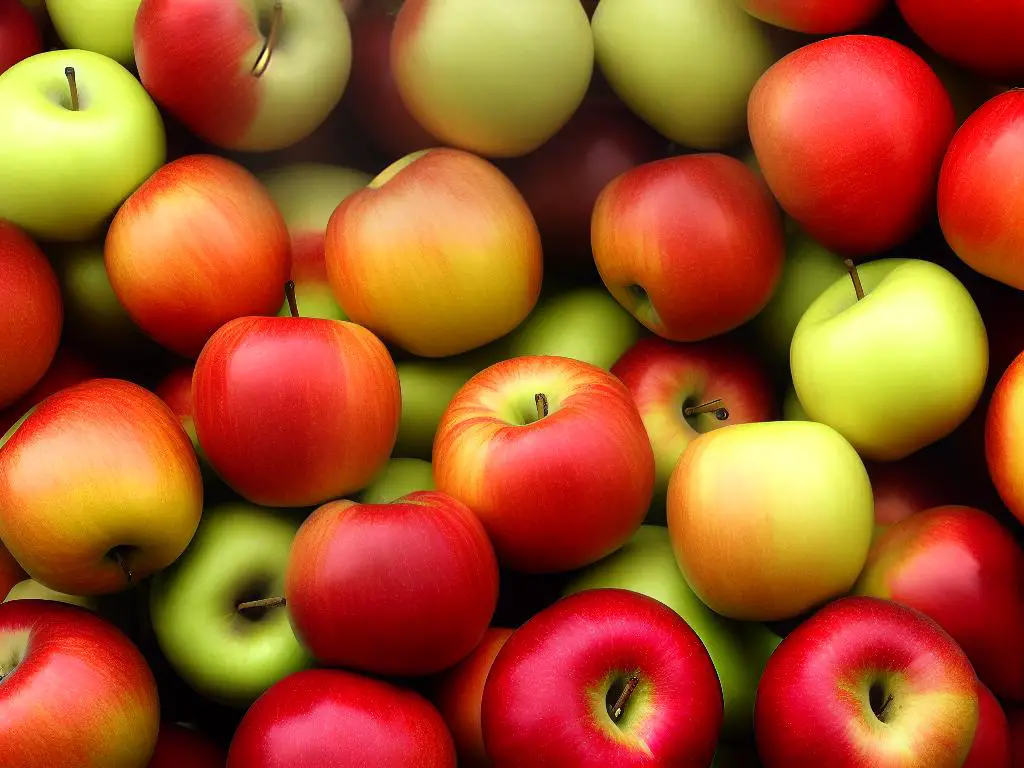Welcome to a voyage of discovery about the delightful and nourishing world of Jonathan apples. Originating from an American family orchard, this apple variety has a rich story rooted in history and has spread its branches across the globe, winning over taste buds and enhancing human health. Packed full of vitamins, minerals, and fiber, Jonathan apples are not just a delicious treat but also a remarkable health ally, contributing to heart health, weight management, and overall wellness. Beyond their health benefits, Jonathan apples also play a star role in culinary creations ranging from baking to savory dishes, and from beverages to preserves. Guiding you on selecting, storing, and preparing these apples, this deep dive into Jonathan apples holds valuable information for every apple enthusiast who values a well-rounded taste with a health benefit attached.
Origins and History of Jonathan Apples
Origins and History of Jonathan Apples
The Jonathan apple traces its roots back to Woodstock, Ulster County, New York in the early 19th century which was discovered by a man named Jonathan Hasbrouck. The name Jonathan was attributed to this particular variety – honoring Hasbrouck’s significant find. This apple variety is believed to be a seedling of one of the many varieties that the first settlers and pioneers brought to North America. Some fruit historians speculate that it could be a descendant of the ‘Esopus Spitzenburg’ apple, another popular variety in the region during that period.
Characteristic Features and Qualities of Jonathan Apples
Jonathan apples are known for their rich, tart flavor, making them a favorite for both fresh consumption and cooking. They have a medium-sized, round to conical shape, with a skin that is usually covered in a green to yellow base color, overlaid with a blush of reddish striping. The flesh is crisp, juicy, and creamy white, offering a sweet-tart flavor with a hint of spiciness. Their high acid content helps maintain their flavor during cooking, making them excellent for baking, sauces, and cider.
Their balanced flavor profile makes them an excellent companion to savory dishes. They add a refreshing touch in salads, complement cheese platters, and their juice is even used as an antidote to the fattiness of traditional dishes like pork roast.
Unlocking the Heritage of Apples through Jonathan Apples
An appreciation of the rich heritage of Jonathan Apples commences with understanding their history and origins. As icons of traditional American apple cultivation, Jonathan apples offer a unique combination of vibrant tastes and balance, proving once again the importance of an apple’s origin in its overall quality.

Health Benefits of Jonathan Apples
Getting Acquainted with Jonathan Apples
Jonathan apples, native to the United States, are an exceptional variety known for a rich, red hue and a flavor marked by a distinctive tangy sweetness. Besides their appealing taste, these apples bring a remarkable nutritional profile to the table, further solidifying their array of health benefits.
Nutritional Profile of Jonathan Apples
Each medium-sized Jonathan apple contains around 95 calories mostly from carbohydrates, with almost no fat or protein. These apples are rich in dietary fiber, providing up to 4 grams per fruit which is about 16% of the recommended daily intake.
Jonathan apples are also an excellent source of Vitamin C, providing nearly 14% of the daily recommended value. They contain other key vitamins like Vitamin A, Vitamin E, and some B vitamins. Jonathan apples are packed with several essential minerals too, like potassium, magnesium, and calcium.
Heart Health and Jonathan Apples
Jonathan apples contain several compounds that promote heart health. The dietary fiber found in these apples can help lower bad cholesterol levels, reducing the overall risk of heart disease.
Further, they are a good source of potassium, a mineral known for its role in maintaining stable blood pressure. The flavonoids present in Jonathan apples, notably quercetin, are believed to have substantial heart-protective properties as they help reduce inflammation and blood pressure.
Jonathan Apples and Weight Management
The dietary fiber in these apples helps promote the feelings of fullness which can prevent overeating and aid in weight management. Various studies have linked apple consumption, including Jonathan apples, to lower risks of obesity. Having a low energy density while being nutrient-rich makes them a healthy snack choice contributing to a balanced diet.
Other Health Benefits of Jonathan Apples
Jonathan apples could contribute to improved gut health. The dietary fiber in these apples plays a significant role in feeding your gut’s beneficial bacteria, fundamental for a robust immune system.
These apples are rich in antioxidants like Vitamin C and flavonoids. These compounds help combat oxidative stress, reducing the risk of chronic diseases (like cancers) and promoting overall well-being.
Jonathan apples are also beneficial for bone health. The presence of vital minerals like calcium and magnesium alongside antioxidant vitamins plays a key role in boosting bone density and strength.
Wrapping Up
When it comes to maintaining a healthy diet, Jonathan apples can be a commendable choice. With their delectable taste, abundance of nutrients, and versatile uses, these apples can be an excellent supplement to your daily menu.

Culinary Uses of Jonathan Apples
Jonathan Apples in the Kitchen: A Delicious and Adaptable Ingredient
Celebrated as an American classic, the Jonathan apple has roots tracing back to the 1820s in New York. These apples boast a red-tinted skin contrasted by a slightly yellow interior. Their flavor profile expertly balances tartness with a hint of sweetness leading to a robust taste experience. Impressively, Jonathan apples offer a delightful raw crunch while also keeping their shape during cooking, making them a popular pick in numerous culinary recipes.
Baking with Jonathan Apples: Adding Sweetness and Tartness
Jonathan apples are perfect for baking applications like pies, tarts, and crumbles. Their tartness balances out the sweetness of desserts and their firm texture ensures that they hold their shape after baking, preventing the dessert from becoming mushy. They are also excellent for use in apple cakes, muffins, and breads due to their rich flavor and moist texture.
Savory Dishes: Adding a Fruity Note
In savory dishes, Jonathan apples can be used in a myriad of ways. They can be included in salads for a sweet-tart crunch, roasted with meats like pork or chicken for a sweet and savory combination, or even turned into apple sauce to be served as a side dish. Further, they can be used in stuffing recipes for poultry, adding a unique and delicious flavor.
Beverages: Using Jonathan Apples for Sweet Refreshment
For beverages, Jonathan apples can be used fresh in apple juices due to their sweet and tangy taste. They can also be incorporated into cocktails as a fresh ingredient or in the form of apple cider. Their crisp and refreshing taste makes them a fantastic addition to a variety of drinks.
Preserves: Making Use of Jonathan Apples All Year Round
One can also turn Jonathan apples into preserves, allowing their unique flavors to be enjoyed throughout the year. Apple butter, jams, jellies, and chutneys made from Jonathan apples have a distinct tart-sweet flavor profile that is perfect to be spread on toast, added to meat dishes, or even used as a filling for pastries.

From humble beginnings in an American family orchard, the reach and influence of the Jonathan apple transcends geographical barriers. Its impressive health benefits make it a preferred choice amongst fruit enthusiasts and health-conscious individuals. Equally significant are its diverse culinary uses, enhancing the flavor and texture of various dishes. As we have delved into today, the universal appeal of Jonathan apples is undeniably engraved in its historical heritage, nutritional contributions, and its culinary versatility. So the next time you bite into a Jonathan apple or incorporate it into your meals, remember the fantastic journey it has encountered, its potent health-lending properties, and its culinary adaptability that makes it a much-loved ingredient in kitchens all around the world.